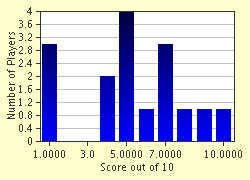Quiz Answer Key and Fun Facts
1. Bernie Ecclestone was best known in F1 as the immensely wealthy controller of the sport, but which F1 team did Ecclestone purchase in 1971 to begin his rise to power?
2. The final race of the 1962 F1 season took place in the city of East London. This event was the first F1 championship race to be held in which Commonwealth country?
3. What name was given to the car run by the team known as Anglo American Racers, which was founded by Dan Gurney and Carroll Shelby?
4. Which Swedish driver made his F1 debut in 2014 with the Caterham team?
5. When a European country has hosted two Grands Prix in the same season, the second race has often been held under the title of the 'European Grand Prix' or 'Grand Prix of Europe'. Which country hosted the first of these races in 1983?
6. Given that very few people each year have the opportunity to race in F1, it's somewhat surprising that there often several drivers with the same first name on the grid at the same time. Which of these names was shared by a Frenchman and a Mexican who first raced each other in F1 in 2016?
7. Engines are a fundamental part of F1, but are much more complicated in the 21st century than the designs that powered F1 cars in the 1950s. Under regulations introduced in 2014, the 'engine' was in fact a power unit made up of six separate major components, two of which were known as the 'MGU-H' and 'MGU-K'. What were these?
8. Which future world champion made his F1 debut at the 1978 German Grand Prix with the Ensign team?
9. Which British driver was awarded the Queen's Gallantry Medal for his role in saving Niki Lauda from his burning car at the 1976 German Grand Prix?
10. Which circuit that hosted the Portuguese Grand Prix was the scene of Ayrton Senna's first F1 victory in 1985?
Source: Author
Fifiona81
This quiz was reviewed by FunTrivia editor
gtho4 before going online.
Any errors found in FunTrivia content are routinely corrected through our feedback system.


